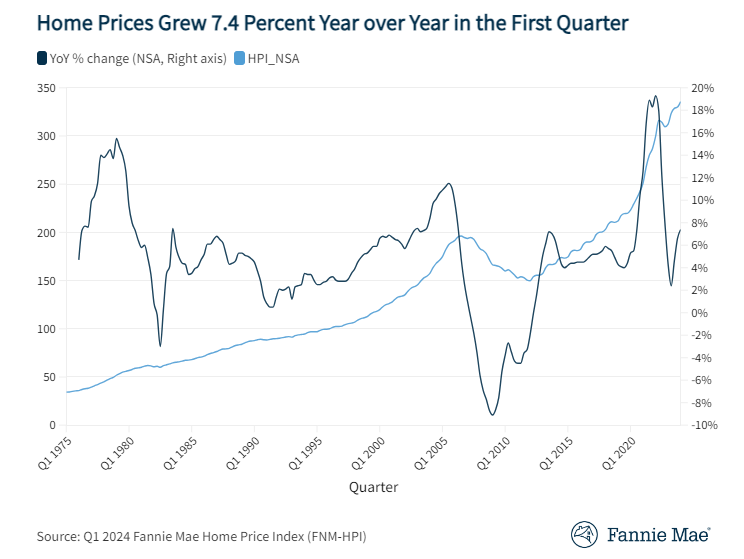Advertisement
GSE Reform: Thinking Outside the Box? (Part III)

In February 2012, the Federal Housing Finance Agency (FHFA) released publicly its “Strategic Plan for Enterprise Conservatorship” in which was established the primary goals of building a new infrastructure for the secondary mortgage market, using the government-sponsored enterprises (GSEs), such that the new standards for mortgage securitization could be emulated by Congress and private market participants in the future. While making note that only Congress could modify the charters of Fannie Mae and Freddie Mac, it was hoped that by slowly ‘sharing’ mortgage credit risk with the private markets FHFA could both contract the GSE’s operations and avoid shocking a sensitive economic recovery. FHFA was acknowledging the need for reform yet their efforts were constrained by their current legal mandate to address only the immediate short-term deficiencies, thus putting the impetus on Congress to affect a long-term strategy. Until it does so, Congress runs the risk of allowing the GSEs and private markets to continue the pass-through of systemic risks to the Treasury, suggesting that the Treasury must be prepared to manage that risk appropriately.
On March 13, the Federal Reserve released its 2012 methodology and results for stress testing large, complex bank holding companies’ capital sufficiency. Though the analysis was explicitly impacted by a singular large housing price stress, the Federal Reserve caveated that the stress was not a forecast, rather a hypothetical scenario to test capital resilience. By avoiding the substantiation of such an integral stress factor, these tests, while perhaps increasing transparency, do not make the Federal Reserve accountable to Treasury for deciding what capital reserves are necessary. That would not be consistent with the duties placed on the Federal Reserve in the 1930s. The Federal Reserve’s dynamic capital supervision is a necessary step to improve the government’s ability to monitor systemic risk, but it does not in itself offer any advancement in how to respond to those risks.
Two weeks later, the FHFA released its 2012 Conservatorship Scorecard which road-mapped the implementation of the strategic plan released a month earlier. Integral to this roadmap was the initiation and execution of new risk sharing transactions by the end of 2012 and through 2013, beyond the charter-required private mortgage insurance. FHFA was suggesting, correctly, that private mortgage insurance was inadequate in helping them achieve their goals yet still mandated by Congress. The following month, FHFA researchers released a working paper entitled “Countercyclical Capital Regime” which was studied how countercyclical capital requirements would have affected Fannie Mae if implemented during the 2002-2010 period. The paper identified housing price indices as the simplest and most direct measure of risk in the mortgage market.
On May 14, I presented to senior executives at Fannie Mae the essential elements of the contingent capital risk sharing process studied by Freddie Mac and suggested they may find greater value in sharing catastrophic financial risk via that process versus relying on the relatively complex and costly MBS platform. Though dismayed, they had not been made aware of this option a year earlier they confirmed its potential viability and suggested further study was warranted.
Two years following the enactment of the Dodd-Frank Act (DFA), on July 18, FSOC released their report to Congress on the suitability of mandating contingent capital for non-bank financial companies. While the report provided an academically thorough review of the concept of contingent capital it made no attempt to perform an actual ‘business’ feasibility analysis (requiring estimated benefits and costs of specific and related structures) which is what was in fact mandated by the DFA. The FSOC concluded that contingent capital instruments should remain an area for continued private sector innovation and encouraged the Federal Reserve and other financial regulators to continue studying how these tools might be incorporated into their capital frameworks. Unfortunately, FSOC may have missed an opportunity to benefit from Freddie Mac’s feasibility study as the overall concerns of such strategies reflected upon in FSOC’s report had been addressed. Incidentally, the report was presented by the same senior Federal Reserve economist that had highlighted to the Brookings Institute in 2011 the inadequacies of private MBS and private mortgage insurance in managing systemic risk. This economist’s earlier recognition that private markets do not innovate tools that manage systemic risk, when considered along with the inability of Congress to get any private investment support for NMAs until decades after their creation, is perhaps contrary to the FSOC’s official findings, in that, it will be the government’s responsibility to create and pay for the tools it needs.
Two years following the enactment of the Dodd-Frank Act (DFA), on July 18, FSOC released their report to Congress on the suitability of mandating contingent capital for non-bank financial companies. While the report provided an academically thorough review of the concept of contingent capital it made no attempt to perform an actual ‘business’ feasibility analysis (requiring estimated benefits and costs of specific and related structures) which is what was in fact mandated by the DFA. The FSOC concluded that contingent capital instruments should remain an area for continued private sector innovation and encouraged the Federal Reserve and other financial regulators to continue studying how these tools might be incorporated into their capital frameworks. Unfortunately, FSOC may have missed an opportunity to benefit from Freddie Mac’s feasibility study as the overall concerns of such strategies reflected upon in FSOC’s report had been addressed. Incidentally, the report was presented by the same senior Federal Reserve economist that had highlighted to the Brookings Institute in 2011 the inadequacies of private MBS and private mortgage insurance in managing systemic risk. This economist’s earlier recognition that private markets do not innovate tools that manage systemic risk, when considered along with the inability of Congress to get any private investment support for NMAs until decades after their creation, is perhaps contrary to the FSOC’s official findings, in that, it will be the government’s responsibility to create and pay for the tools it needs.
By October, several news articles had been written describing the GSE’s attempts to meet the deadlines for risk sharing through the use of PMI and by issuing “Risk Sharing Bonds”, otherwise known as non-guaranteed MBS. The articles highlighted the continued demand to privatize risk in a fashion that Congress and the Administration deemed causes of the financial crisis a year and a half earlier and which fail to address the actual obsolescence of those GSEs.
That month, the FHFA publicly released its updated projections of potential draws required by Fannie Mae and Freddie Mac on the line-of-credit Treasury extended them after they collapsed. The FHFA interpreted these projections as a sensitivity analysis of the economic future of the GSEs as a function of housing prices. Though the likelihood of the presented scenarios was hinted at through reliance on a statistical rating agency’s assessments of housing path probabilities, FHFA made a point to distance this ‘what if’ scenario analysis away from what might actually be expected. Though it forecasted housing prices in an inconsistent fashion than the Federal Reserve had earlier in the year, its non-accountable stance on the projection passed that risk to Treasury just as effectively. HUD followed-up the next month with its annual report to Congress on the financial status of FHA’s mutual mortgage insurance fund. It projected FHA’s current capital reserves would be insufficient to absorb future losses due to downward changes in housing price appreciation forecasts used by the independent actuaries that performed the analysis. While it may be common wisdom that the use of independent analysts can help promote transparency, when the analysis being performed is one related to forecasting the future, it is better to make sure that those with the authority retain accountability. Otherwise, those with authority are not only outsourcing a primary duty, they are increasing financial instability by relying on entities with no “skin in the game.” This is not consistent with DFA’s philosophy and it passes the complex task of reconciling and responding to such risk to Treasury.
2013 Reform Efforts
On Jan. 17, Fannie Mae and Freddie Mac approved the newly created National Mortgage Insurance Corporation as an eligible private mortgage insurer as it was unburdened by legacy losses that all of the PMI businesses that preceded it then had due to their concentrated speculation on housing prices.
That month, the FHFA publicly released its updated projections of potential draws required by Fannie Mae and Freddie Mac on the line-of-credit Treasury extended them after they collapsed. The FHFA interpreted these projections as a sensitivity analysis of the economic future of the GSEs as a function of housing prices. Though the likelihood of the presented scenarios was hinted at through reliance on a statistical rating agency’s assessments of housing path probabilities, FHFA made a point to distance this ‘what if’ scenario analysis away from what might actually be expected. Though it forecasted housing prices in an inconsistent fashion than the Federal Reserve had earlier in the year, its non-accountable stance on the projection passed that risk to Treasury just as effectively. HUD followed-up the next month with its annual report to Congress on the financial status of FHA’s mutual mortgage insurance fund. It projected FHA’s current capital reserves would be insufficient to absorb future losses due to downward changes in housing price appreciation forecasts used by the independent actuaries that performed the analysis. While it may be common wisdom that the use of independent analysts can help promote transparency, when the analysis being performed is one related to forecasting the future, it is better to make sure that those with the authority retain accountability. Otherwise, those with authority are not only outsourcing a primary duty, they are increasing financial instability by relying on entities with no “skin in the game.” This is not consistent with DFA’s philosophy and it passes the complex task of reconciling and responding to such risk to Treasury.
2013 Reform Efforts
On Jan. 17, Fannie Mae and Freddie Mac approved the newly created National Mortgage Insurance Corporation as an eligible private mortgage insurer as it was unburdened by legacy losses that all of the PMI businesses that preceded it then had due to their concentrated speculation on housing prices.
The following day, as mandated by DFA, six federal regulatory agencies issued the final rule establishing new property appraisal requirements for higher-priced mortgage loans. The rule placed total responsibility for developing federal suitability standards for property valuation in the hands of the Appraisal Standards Board of the Appraisal Foundation, which is exactly where it was before the financial crisis. Total reliance on an entity without authority or accountability is not only inconsistent with DFA’s treatment of the statistical rating agencies, it leaves a significant and non-transparent source of housing price volatility within the financial system.
On Jan. 30, at the meeting of the Federal Open Market Committee (FOMC) it was deemed necessary to continue the programmatic purchasing of $40 billion of GSE-guaranteed MBS and $45 billion of longer-term Treasury securities, per month, to “foster a stronger economic recovery in context of price stability.” The FOMC’s reliance on MBS, a tool that confounds systemic and borrower specific risks, may be a necessary means to influence short-term pricy stability, but it does not, in and of itself, set the right precedent for how the government should approach long-term systemic risk management in housing finance.
Incidentally, the FOMC made reference to the option-implied price of insurance against long-term downside risk of the S&P 500 stock index. This acknowledgement of the need to gauge private capital market sentiment for future systemic financial risk is key to understanding how Treasury might create more stable housing price forecasts. While option derivatives, being financial tools heavily laden with counterparty risk, are not appropriate for getting accurate pricing of systemic risks, a financial tool designed without counterparty risk which combines both Treasury securities and housing price indices would be (and let the Federal Reserve ‘kill two birds with one stone’ as well). Creating a marketplace for such a tool was in fact the proposal that Freddie Mac made to FHFA and Treasury in early 2011.
On Feb. 25, the Bipartisan Policy Center (BPC) formally presented their recommendation that the U.S. replace Fannie Mae and Freddie Mac with a single government-owned corporation that will provide government guarantees on MBS against catastrophic losses. The authors recognized what should be a natural up and down cycle of housing prices and suggest that the tendency of many ‘actors’ within the market to convince themselves that prices only go up should be addressed in the future housing finance system through some form of countercyclical capital buffering. Central to creating that buffer is their recommendation that a significant amount of private capital be in a first-loss position ahead of the government, where the new Public Guarantor would determine the minimum, yet dynamic, amount of buffer required to cushion the government from a drop in housing values no less extreme than what was experienced during the recent crisis, i.e. “30 to 35 percent.” Taken at face value, these opinions might suggest the creation of a public investment trust which is fully diversified against collateral value risk such that it promotes liquidity while not also creating a speculative investment opportunity for the private markets. Notwithstanding the criticism that such a trust would be providing liquidity where it is not needed, i.e. redundant, this is not the structure actually being suggested by the BPC.
The report did not propose limiting LTVs to the 50-60 percent required to shield a lender from losses related to a BPC-level systemic housing price shock and related fixed costs (always incurred when foreclosing and liquidating homes). Instead, it is suggested that a housing price shock of that magnitude “would correspond to aggregate credit losses of four to five percent on prime loans.” There is a lot of assumption embedded in the transition from a 35 percent drop in housing prices to a five percent loss. First of all, that loss approximation was based on rough estimates of what the GSEs better quality loans had experienced throughout the crisis. Those losses would probably have looked different had Treasury not bailed-out the GSEs with $180 billion, so any loss expectations pegged to that figure is necessarily shy of what is needed to avoid a government bail-out during a mortgage market stress such as the U.S. just experienced. Secondly, the BPC’s assertion that “prudent underwriting is the single most effective way to mitigate risk in the system” while also failing to include LTV amongst the “traditional factors” that a lender should consider reinforces the Administration’s official stance that borrower credit risk took a larger role in the crisis than the overall leverage to housing prices. A Public Guarantor that divorces housing prices from mortgage credit in such a way can only be defined as a pro-cyclical entity, just as the GSEs have always been, ergo its creation would not address any issues of obsolescence. Treasury would only continue to wear the type of systemic risk it did prior to the financial crisis.
On Feb. 28th, at a meeting with a new team of senior capital market and housing finance policy analysts at Treasury, I presented evidence of their continued acceptance of, and sensitivity to, systemic housing market risk. Initial reactions suggested belief that, given popular academic forecasts for upward trending housing prices, systemically important financial institutions were adequately capitalized against future housing price shocks. As such, there was little concern for additional near-term Treasury bailouts. However, upon further discussion it was realized that reliance on housing price forecasts from entities without skin in the game is inconsistent with DFA’s declaration of financial stability through accountability and that Treasury’s responsibility goes beyond supporting only short-term recovery efforts. It was advised that for long-term stable economic expansion Treasury should be studying and advocating for the creation of a capital market for housing prices.
A week later, after relaying to Freddie Mac the discussion points covered with Treasury, they conveyed to me that they were focusing on a credit-linked note (CLN) strategy, as opposed to the contingent capital strategy at the heart of our prior joint study, for the purpose of satisfying their risk sharing quota placed upon them by FHFA. The prioritization was, or is, based on perceived “increased hedge effectiveness and reduced basis risk” which would seem to be at odds with both the results of our earlier study on the matter and FHFA’s own suggestion the previous year that housing price indices were the simplest and most direct measure of risk in the mortgage market (the contingent capital strategy relied on housing price indices as the triggering mechanism). CLN on the other hand, in this context, are a type of residential mortgage-backed security (RMBS) where an institutional counterparty, like Freddie Mac, ‘promises’ to pay bond investors monies related to the performance of mortgage loans, where the loans themselves are not actual collateral to be held for the benefit of the bond investor. CLN were discussed briefly within the BPC report as a source of private credit enhancement and, though never used by the GSEs in the past, were used extensively by the private capital markets, especially banks, prior to the financial crisis. As they embed a level of counterparty risk on top of what RMBS already possess, the suitability of such a risk sharing process must be carefully analyzed as to avoid to their contributing certain risks to the overall financial system as detailed in the FCIC report.
The following June, a draft of the Housing Finance Reform & Taxpayer Protection Act is released. This GSE reform bill is centered on the creation of a Federal Mortgage Insurance Corporation (FMIC) which will, as recommended by the BPC, replace the GSEs with a single U.S. owned corporation that will provide government guaranteed catastrophic mortgage insurance. That same month, Credit Suisse Group AG downgraded a large reinsurance company called Validus Holdings Ltd. Credit Suisse based its decision on the fact that Validus’ insurance company clientele were moving toward the use of contingent capital instruments as a more effective way to manage their weather-related catastrophic property risks. This re-raises the question of the appropriateness of creating an insurance company, such as the FMIC, which is meant to handle catastrophic systemic risk while only being capitalized to handle diversifiable risks, when the private insurance markets themselves have recognized the inadequacy of that business model for such a task. It also suggests Congress and the Administration should revisit and refine the idea of contingent capital as a basis to privatize systemic risks.
In July, Freddie Mac released the offering documents for its new risk sharing bond, a CLN called Structured Agency Credit Risk (STACR) securities. These documents describe how only hypothetical loan losses are to be shared with STACR bond investors, not actual losses, by establishing pre-set loss amounts for any loan that defaults based solely on the overall level of defaults within the reference portfolio, regardless of how, for example, housing prices fluctuate in the future. Though Freddie Mac has met the strict interpretation of FHFA’s quotas for risk sharing it has also, by divorcing housing prices from mortgage risk, impeded regulators from gaining private market substantiation of their hypothetical forecasts of a critical measure of systemic risk.
Another feature of this structure is that it will give Freddie Mac an actual profit on every loan that defaults which does not experience a loss as severe as was pre-set, when, for example, housing prices are stable or increasing. This creates an odd incentive given, as written in the STACR offering circular, “Freddie Mac does not re-underwrite the mortgage loans it acquires from its sellers, which may adversely affect the performance of the reference obligation.” Without retaining any accountability for the loans it is insuring or securitizing there can only be greater performance instability in those loans, per DFA, which suggests that Freddie Mac is currently engineered to speculate on the price appreciation resulting from the Administration’s steps to affect a short-term economic recovery. That’s the type of pro-cyclical feedback loop that may not be consistent with the Pecora Committee’s suggestion for the proper use of investment trusts.
More to this point, the following November, a second STACR transaction was issued in which a bond insurance company participated by providing Freddie Mac contractual protection on the performance of bonds that were not otherwise sold to investors. In essence, the insurance company purchased the bonds, yet would not pay the full amount upfront. The company, Arch Reinsurance Ltd., was required only to provide capital equivalent to 9.5 percent of the value of the bonds it insured, such capital being held in trust by a third-party. While it may be argued that Arch Re, a subsidiary of the larger Arch Capital Group Ltd. insurance company, is a more reliable counterparty due to its reliance on a stronger diversified parent, one has only to consider the events of AIG’s failure and Arch Capital’s subsequent acquisition of two failed private mortgage insurance companies in January of this year to begin wondering how long diversified will be ‘diversified.’
While STACR is innovative in the sense that it may help gauge the capital market’s view of borrower credit risk under one particular economic scenario, it by itself restricts the flow of information regarding the broader market’s view on the likelihood of that scenario occurring, ergo regulators have less information concerning housing prices than they had by examining normal private MBS. The information becomes even less clear when complex insurance and reinsurance risks are layered in. The contingent capital study performed by Freddie Mac showed them a way to improve the management of housing price risk by giving the capital markets a product through which they could express their outlook on those prices free of the credit and counterparty risks that confounded attempts to do so with the existing tools.
The road ahead
Regardless of the motivations behind them there exists a common thread within the public and private financial markets to facilitate a degree of speculation that can, and will, go too far. In those temporary moments of clarity following the financial crisis that results from going too far, the common threads become exposed. In 1929, it was the manipulation of private market financial tools to concentrate corporate risks such that a stable market could be inflated and then skimmed by a small number of private investors. The government followed up by creating its own financial tool that would diversify borrower risk while concentrating housing price risk such that a depressed market could be re-inflated and then skimmed by everyone. If only they had remembered, or had the discipline, to identify stability while not forgetting what had caused the instability to begin with then perhaps the 2008 crisis would have been avoided. Nevertheless, it happened. This time, it was the manipulation of both public and private financial tools to concentrate credit, counterparty and collateral risks such that an already leveraged market could be inflated even further. The GSEs, while having some very specific issues unique to them, are probably more a reflection of the inadequacies and super-adequacies of the government’s attempts to achieve its overall goal of stable economic expansion. Yet, the size and scope of the GSEs are such that they have a real impact on the U.S. economy which means reforming them is both a must and an opportunity to sew the seed for broader change in how the government participates within the financial markets.
While STACR is innovative in the sense that it may help gauge the capital market’s view of borrower credit risk under one particular economic scenario, it by itself restricts the flow of information regarding the broader market’s view on the likelihood of that scenario occurring, ergo regulators have less information concerning housing prices than they had by examining normal private MBS. The information becomes even less clear when complex insurance and reinsurance risks are layered in. The contingent capital study performed by Freddie Mac showed them a way to improve the management of housing price risk by giving the capital markets a product through which they could express their outlook on those prices free of the credit and counterparty risks that confounded attempts to do so with the existing tools.
The road ahead
Regardless of the motivations behind them there exists a common thread within the public and private financial markets to facilitate a degree of speculation that can, and will, go too far. In those temporary moments of clarity following the financial crisis that results from going too far, the common threads become exposed. In 1929, it was the manipulation of private market financial tools to concentrate corporate risks such that a stable market could be inflated and then skimmed by a small number of private investors. The government followed up by creating its own financial tool that would diversify borrower risk while concentrating housing price risk such that a depressed market could be re-inflated and then skimmed by everyone. If only they had remembered, or had the discipline, to identify stability while not forgetting what had caused the instability to begin with then perhaps the 2008 crisis would have been avoided. Nevertheless, it happened. This time, it was the manipulation of both public and private financial tools to concentrate credit, counterparty and collateral risks such that an already leveraged market could be inflated even further. The GSEs, while having some very specific issues unique to them, are probably more a reflection of the inadequacies and super-adequacies of the government’s attempts to achieve its overall goal of stable economic expansion. Yet, the size and scope of the GSEs are such that they have a real impact on the U.S. economy which means reforming them is both a must and an opportunity to sew the seed for broader change in how the government participates within the financial markets.
If financial crisis are defined by drops in asset prices and the government’s goal is, as stated within DFA, to promote systemic financial stability then their task of reducing the likelihood and severity of future crisis can only be achieved by improving the ability to both monitor and respond to changes in those prices. When addressing the nature of financial stability at the annual gathering of the American Economic Association in January, Ben Bernanke observed in his last public speech as Chairman of the Federal Reserve that “the immediate trigger of the crisis, as you know, was a sharp decline in house prices” and that “the tools used to fight the panic, though adopted to the modern context, were analogous to those that would have been used a century ago.” If only 2014 Bernanke could reach out to 2008 Bernanke, the latter of which had noted in his opening address to the Jan. 9 FOMC conference call that “I don’t think that we can claim that we have done anything in the way of taking out insurance against what I think are some potentially significant downside risks.” Change comes from changing and those within the government can be most effective when they advocate for the necessary reforms while they still have the authority to affect that reform. That’s the job. Reliance on obsolete tools is a legacy that needs to change.
With respect to the GSEs, as long as every act by Congress, the Administration and the independent regulators makes a clear improvement to both transparency and accountability around housing prices they will be affecting long-term reform no matter how simple or complex those acts are.
 Ryan W. Birtel is founder and managing director of Eolith Advisory Ltd., an independent consulting firm that provides economic and financial advisory services related to the real estate and structured finance markets. He may be reached by phone at (646) 707-1502 or e-mail [email protected].
Ryan W. Birtel is founder and managing director of Eolith Advisory Ltd., an independent consulting firm that provides economic and financial advisory services related to the real estate and structured finance markets. He may be reached by phone at (646) 707-1502 or e-mail [email protected].This article originally appeared in the April 2014 print edition of National Mortgage Professional Magazine.
About the author





